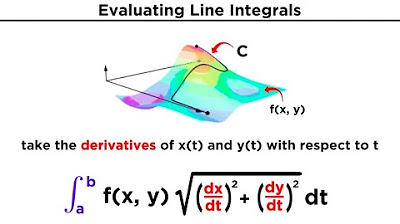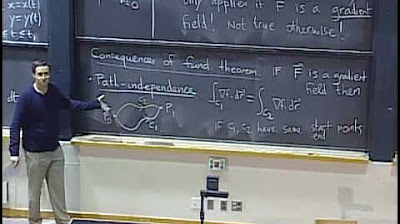Parametrization of a reverse path | Khan Academy
TLDRThe video script discusses the concept of line integrals over scalar and vector fields and explores the effect of changing the direction of the path on these integrals. It introduces a method to construct a parameterization for a curve that follows the same shape but in the opposite direction, using the example of a curve C and its reverse, -C. The script sets the stage for future videos that will delve into the impact of path reversal on line integrals for scalar and vector fields.
Takeaways
- 📌 The topic is exploring the impact of changing the direction of a line integral, both for scalar and vector fields.
- 🔄 The script introduces a concept where a line integral is taken over a curve and then over its reverse, denoted as 'minus C'.
- 🛤️ The parameterization of the curve is defined by functions x(t) and y(t), where t ranges from a to b.
- 🔄 To reverse the path, the parameterization is adjusted to start at the endpoint and end at the starting point, using t = a and t = b for the reverse curve.
- 🔢 The parameterization for the reversed curve is achieved by substituting t with a + b - t for both x and y functions.
- 🎯 The script verifies that the endpoints of the original and reversed curves match by evaluating the parameterizations at t = a and t = b.
- 🔄 The intuitive understanding is that as t increases, the original curve moves from the starting point to the endpoint, while the reversed curve does the opposite.
- 📈 The next step is to evaluate how the line integral changes when computed over the reversed path for scalar fields.
- 📊 Following the scalar field analysis, the same investigation will be applied to vector fields.
- 🤔 The overarching goal is to understand how the direction of a path affects the computation of line integrals in different mathematical contexts.
Q & A
What is the main topic of the video script?
-The main topic of the video script is the exploration of how changing the direction of a path affects the line integral, both for scalar fields and vector fields.
What is a line integral?
-A line integral is a mathematical concept used to calculate the accumulated effect of a scalar field or vector field along a curve or path in space.
How does the script introduce the concept of changing the direction of a path?
-The script introduces the concept by using a curve C and its reversed counterpart, denoted as minus C, to demonstrate how the same curve can be traversed in opposite directions.
What is the parameterization of the original path?
-The original path is parameterized by x(t) = x(t) and y(t) = y(t), where t ranges from a to b.
How is the parameterization of the reversed path defined?
-The parameterization of the reversed path is defined by x(t) = x(a + b - t) and y(t) = y(a + b - t), where t also ranges from a to b.
Why is the parameterization of the reversed path constructed in that way?
-The parameterization of the reversed path is constructed in that way to ensure that the starting point of the reversed path corresponds to the endpoint of the original path, and vice versa, thus allowing for a direct comparison of line integrals along both paths.
What are the endpoints of the parameterized paths?
-The endpoints of the original path are (x(a), y(a)) when t equals a, and (x(b), y(b)) when t equals b. For the reversed path, the endpoints are (x(b), y(b)) when t equals a, and (x(a), y(a)) when t equals b.
How does the script confirm that the parameterization of the reversed path is correct?
-The script confirms the correctness of the parameterization by showing that when t equals a or b, the coordinates (x, y) match the desired endpoints, and by explaining the intuitive behavior of the parameterization as t increases.
What is the significance of understanding the effect of changing the direction of a path on line integrals?
-Understanding the effect of changing the direction of a path on line integrals is significant because it can reveal important properties of the underlying fields and their symmetries, as well as the behavior of the integral in relation to the path taken.
What is the plan for the subsequent videos mentioned in the script?
-The plan for the subsequent videos is to evaluate the line integrals for scalar fields and vector fields using the original and reversed paths, to see how the direction of the path affects the results.
How can the concepts discussed in the script be applied in practical scenarios?
-The concepts discussed in the script can be applied in various practical scenarios, such as modeling fluid flow, electric fields, and other physical phenomena where the path of integration can impact the outcome of the analysis.
Outlines
📐 Exploring the Effects of Changing Path Direction on Line Integrals
The paragraph discusses the concept of line integrals and how they are affected by changing the direction of the path in the context of scalar and vector fields. It introduces a curve C and its parameterization, then describes the reverse path, denoted as minus C. The focus is on understanding how to construct a parameterization for the reverse path and the implications for line integrals. The explanation includes a review of parameterization basics and the construction of a new parameterization that starts at the endpoint of the original path and ends at its starting point, effectively reversing the direction. The paragraph aims to build an intuitive understanding of how reversing the path direction impacts the line integral before exploring this concept further in subsequent videos for scalar and vector fields.
🔄 Confirming the Intuition of Reverse Path Parameterization
This paragraph continues the discussion on the reverse path parameterization, emphasizing the need to confirm that the newly constructed parameterization indeed represents the same curve but in the opposite direction. It explains the process of evaluating the parameterization at the endpoints t equals a and b, demonstrating that the coordinates match those of the original path when the direction is reversed. The paragraph reinforces the idea that as t increases, the value of the parameterization moves from the endpoint back towards the starting point, thus confirming the intuition of the reverse path. It concludes by setting the stage for the next video, which will investigate the impact of this reverse path on the line integral of a scalar field, and the subsequent video will extend this investigation to vector fields.
Mindmap
Keywords
💡Line Integral
💡Scalar Field
💡Vector Field
💡Parameterization
💡Curve C
💡Path Direction
💡Coordinate System
💡t-Parameter
💡Endpoint
💡Intuition
💡Mathematical Functions
Highlights
The exploration of line integrals over scalar and vector fields when the direction of the path is changed.
The introduction of a curve C and its parameterization in relation to the x- and y-axes.
Defining a reverse path, denoted as minus C, with the same shape but in the opposite direction.
The construction of a parameterization that starts at the endpoint of the original path and ends at the starting point.
The definition of the parameterization x(t) = x(a + b - t) and y(t) = y(a + b - t) for the reversed path.
Verification of the parameterization at t = a, resulting in the coordinates (x(b), y(b)).
Verification of the parameterization at t = b, resulting in the coordinates (x(a), y(a)).
The intuitive understanding that as t increases, the value decreases from x(b), y(b) to x(a), y(a).
Confirmation that the constructed parameterization represents the same curve but in the opposite direction.
The plan to evaluate the line integral of a scalar field over the original and reversed paths in the next video.
The announcement of a subsequent video that will explore line integrals over vector fields with the reversed path.
The importance of understanding how changing the direction of a path affects line integrals.
The mathematical approach to reversing the path by manipulating the parameter t.
The practical application of this concept in understanding the behavior of line integrals under different path directions.
The theoretical contribution to the understanding of vector calculus through the examination of line integrals.
The innovative method of using parameterization to visualize and analyze the effects of path direction on line integrals.
Transcripts
Browse More Related Video

Vector field line integrals dependent on path direction | Multivariable Calculus | Khan Academy

Evaluating Line Integrals

Stokes' theorem proof part 4 | Multivariable Calculus | Khan Academy

Lec 20: Path independence and conservative fields | MIT 18.02 Multivariable Calculus, Fall 2007

Scalar field line integral independent of path direction | Multivariable Calculus | Khan Academy

Conservative Fields & Path Independence (Vector Fields)
5.0 / 5 (0 votes)
Thanks for rating: